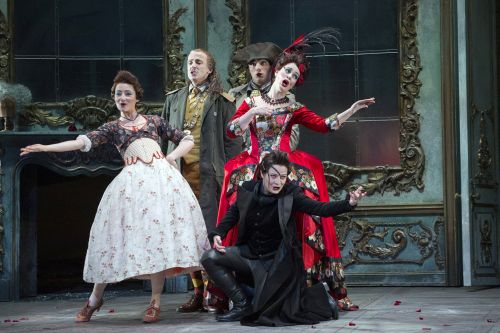 United Kingdom Mozart, La finta giardiniera: Glyndebourne Touring Opera, Glyndebourne Tour Orchestra / Christopher Moulds (conductor), Glyndebourne Opera, Sussex 14.10.2014 (MH)
United Kingdom Mozart, La finta giardiniera: Glyndebourne Touring Opera, Glyndebourne Tour Orchestra / Christopher Moulds (conductor), Glyndebourne Opera, Sussex 14.10.2014 (MH)

Cast
Don Anchise (Il Podestà, Mayor of Lagonero): Timothy Robinson (tenor)
Sandrina (La Marchesa Violante Onesti): Rosa Feola (soprano)
Arminda: Eleonore Marguerre (soprano)
Count Belfiore: Enea Scala (tenor)
Ramiro: Hanna Hipp (mezzo soprano)
Serpetta: Eliana Pretorian (soprano)
Nardo (Roberto): Mattia Olivieri (baritone)
Production
Director: Frederic Wake-Walker
Designer: Antony McDonald
Lighting Designer: Lucy Carter
The Glyndebourne Tour 2014 is dedicated to its visionary founder Sir George Christie.
He established the Touring Opera in 1968 driven by an ambition to bring the highest quality opera to as many people as possible and nurture talented singers from across the world at the start of their careers. This Production is direct from the Festival, but with a new cast. Sung in Italian with English surtitles. Libretto: Anonymous text, thought to be by Giuseppe Petrosellini after Goldoni.
Now in its 46th year, commencing with performances at Glyndebourne the Tour will visit Woking, Norwich, Canterbury, Milton Keynes, Plymouth, Dublin and Stoke-on-Trent.
Arts Council England provides the bedrock of funding that makes Glyndebourne’s innovative Tour and education work possible and for the fourth year the Daily Mail is also providing valuable sponsorship of Glyndebourne Tour. Having spent eight of my formative singing years at the original House it was delightful to visit the New House again and see how it had developed. Most noticeable was the crisp immediacy of the sound.
Described as a Dramma giocoso in three acts, Mozart’s La finta giardiniera takes place in the 18th century on an estate in Lagonero. It has a complicated plot of love and madness. Unseen is the violence where Count Belfiore has stabbed Marchesa Violante – following a lovers’ tiff maybe. Surviving, she recovers and disguises herself as Sandrina – a gardener along with her servant Roberto – now called Nardo. They work for Il Podestà – the Mayor of Lagonero who has fallen madly in love with Sandrina. She soon discovers that the Count has become betrothed to Arminda – the Mayor’s niece who has forsaken her admirer Ramiro. After much confusion and mistaken identity Belfiore admits his lasting love for the Countess, causing a jealous Arminda to arrange for Sandrina (the Countess) to be kidnapped and abandoned. Thanks to Ramiro, the two are reunited and imagine themselves to be Greek Gods with the other protagonists as forest nymphs. Following much madness the Count and Countess are reunited to the delight of Ramiro who regains his Arminda. Roberto finds his soul mate in Serpetta the Mayor’s Maid, and possibly everyone lives happily ever after.
The lavish, quirky set from Antony McDonald was of the late Baroque – 18th century with Louis XV shell curves, mirrors, a central fireplace, doors, shuttered windows and doors, some with no glass! During the interval this set was cleverly replaced with similar looking scenery which literally fell apart. This setting worked well as a backcloth to the Commedia dell ‘arte style of movement chosen by Director Frederic Wake-Walker. Frequent changes of cast gestures throughout the opera conveyed a mannered representation of the confusion in the minds of the characters. This was at first seen during the overture following Count Belfiore’s wounding the Marchioness. The other characters appeared in a revolving circulation of gestures which resolved into a sequence the next morning with the quintet “Che lieto giorno”. It was then easy to understand the logic in this approach to love and madness which was to dominate the production. Nice touches included the knife used by the Count which stayed on set throughout the opera and the pantomime run around approach to panic. The set literally falls apart in the second Act, representative of the way love can make anyone’s world disintegrate and leaving us to wonder if all the action has been one mad dream.
The character tenor role of the Mayor sung by Timothy Robinson was an enjoyably stylised
interpretation showing his vocal maturity in his admiration for Arminda in “Che beltà”.
Award winning Italian soprano Rosa Feola made her Glyndebourne debut as Sandrina the heroine in ghostly makeup. She was totally in character throughout and left one feeling really sorry for her after she had been abducted and deserted in “Crudeli, fermate!” – Act 2. The reconciliation duet “Tu mi lasci?” at the end of the opera brings the Count and Marchesa back together in fine vocal colour. Count Belfiore shows us his manly figure at intervals throughout the opera; at times removing not only shirt, but wig as well! Italian tenor Enea Scala relishes the role and easily entrances in his “Care pupille” serenading of Sandrina.
Tour favourite Eliana Pretorian as Serpettta makes the most of her shrewish soubrette role, interfering, commenting and generally getting in the way. Her Act 2 balancing statue pose on the mantelpiece showed an amazingly high degree of physical control before springing to life again. Polish mezzo-soprano Hanna Hipp, a graduate of the Royal Opera House’s Jett Parker Young Artists programme, took the trouser role of Ramiro. A striking characterisation and clear tone was enhanced by the Goth style outfit making him a lover for Arminda who was not easily thwarted. The second gardener in the piece is Nardo who is really Roberto sung by baritone Mattia Olivieri. Here again was a physically nimble, well sung character, appearing at intervals to interject by removing pieces of scenery.
Christopher Moulds guided both the Glyndebourne Tour Orchestra and the singers with consummate skill. His familiarity with the piece was obvious, knowing every word and nuance. He is definitely a singers conductor, sympathetic to their every breath – a rarity, dare I say.
For details of the Glyndebourne Tour see http://glyndebourne.com/season/glyndebourne-tour-2014
Martyn Harrison